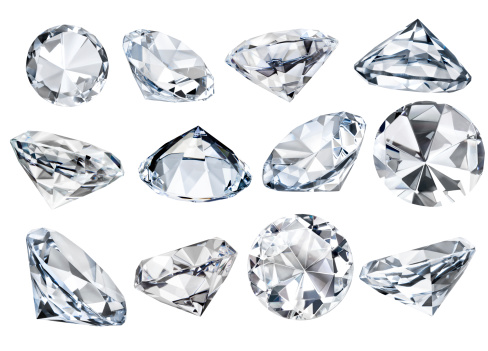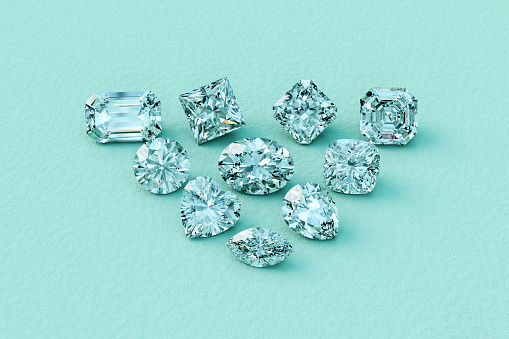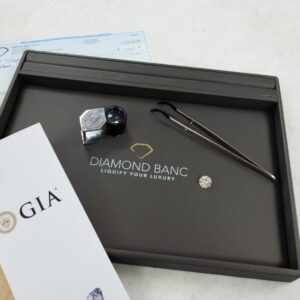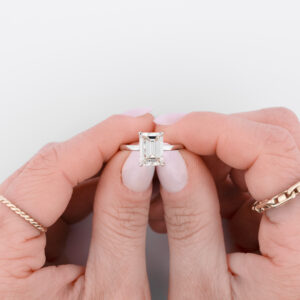Diamonds are one of the most well-known and sought-after gemstones that you can purchase. There are hundreds of different colors, cuts, shapes, and sizes to choose from: laboratory grown diamonds or natural. So what is the difference between the two? A more in-depth look is needed to determine the difference.
Lab Grown And Real Diamonds
In 2018 alone, 147 million carats of diamonds were sold, including jewelry and loose stones. Diamonds account for most gemstones sold each year and tend to grow in value with each passing year. Diamonds are one of the hardest elements, making it a durable and long-lasting stone that can be passed down from generation to generation.
Real diamonds are created deep within the crust of the earth through years of intense compression. Diamonds are formed when coal is under immense pressure deep within the earth’s surface and exposed to extreme heat then either mined or pushed to the surface through volcanic eruptions. The rarity and time it takes for these stones to form make them so valuable and desirable, naturally.
The criteria that diamonds are graded on based on the cut, the clarity, the color, and the carat weight. These factors determine how much a diamond is worth and how much it can be sold for. These factors apply to both natural and lab-created diamonds, though they are easier to control in lab-created stones than they are in natural diamonds. The clearer, larger and better the cut is, the more it is worth.
How Are Lab Diamonds Made?
Lab diamonds are created by mimicking or recreating the pressure and heat that occurs in the earth’s crust to form diamonds. Through years of research and trial and error, lab diamonds are more common now than ever before, and there are methods in which they can be created effectively and efficiently.
METHODS OF CREATING LAB DIAMONDS
There are two different methods for creating lab diamonds; the first is HPHT. This method is also known as the High-Pressure High-Temperature method. This is a method in which a tiny piece of a diamond is placed on a piece of carbon. The diamond and carbon are then pressed by either a belt press, a cubic press, or a split sphere press and pressurized to 1.5 million pounds per square inch. This simulates the millions of years of pressure that a diamond goes through while on the surface of the earth.
The diamond is also exposed to temperatures of over 2,700 Fahrenheit to simulate the extreme heat in the crust of the earth as well. The heat melts the carbon, and the pressure forces it to reform around the diamond seed and form a larger diamond. The diamond is then cooled to be used in jewelry or be sold as a loose stone.
Another method for lab-created diamonds is the CVD method or Chemical Vapor Deposition method. This method also uses a small diamond seed, which came from the first method we discussed. The diamond seed is put into a chamber that is sealed and heated to temperatures over 1,400 degrees Fahrenheit, and then carbon-filled gas is pumped into the chamber. The gas is ionized using plasma technology and lasers that break down the gas and the molecular bonds of the carbon in the gas. The carbon will then stick to the seed and create a larger diamond that can be cooled and shaped. This process allows the lab to use methods that enhance the color of the diamond and the clarity as well, and they can even use treatments to change the color of the diamond after it has been formed.
What Is the Difference Between CVD And HPHT Diamonds?
HPHT diamonds generally use at least a portion of a real diamond to start, so they are not fully synthetic diamonds; they have origins in natural diamonds. The diamond is fully synthetic with a CVD diamond and usually uses parts of an HPHT diamond as the diamond seed. Both are gorgeous and rival natural diamonds when they are complete and when they have been shaped and cut into jewelry.
The CVT diamonds will also be more controlled in terms of color, clarity, and look after they are completed. Because these diamonds are fully lab-created, those creating them do have a bit more control in how they look at the end. They can also use unique treatments to change the color of the diamond after it has formed, the clarity of the diamond, and they can better control the finished product.
While creating a natural diamond in the earth’s crust takes millions of years, it takes around two weeks to make a lab diamond and get it ready to be used in jewelry or be sold as a loose stone. This type of diamond is more socially responsible as there are fewer issues regarding how they are harvested around it and rights to mines. They are also better for the environment as the earth is not being disturbed to mine them, and they are essentially being created as demand emerges for them.
Is It Worth Buying A Lab Created Diamond?
When buying a lab-grown diamond over a natural diamond, there are some things to keep in mind. Natural diamonds are mined from the earth. Hundreds of thousands of pounds of soil have to be sifted to find just one carat of diamond to mine diamonds. This means that people have to manually sift the dirt to find very little in terms of diamonds and payback.
On top of that, many diamond mines are in highly contested areas where forced labor is still used to run the mines. This means that some diamonds may impact the lives of the people who mined them and may be part of the blood diamond trade; there is no way you can know as a buyer. Lab-created diamonds take less time to make, they have less of a negative impact on the environment, and they are going to be easier to access than a natural diamond might be.
They are also designed to look as much like a natural diamond as possible. Though they are created in a lab, they still look and feel like a natural diamond, which greatly benefits those who prefer to buy this type of diamond. Lab-created diamonds are also often less expensive than natural diamonds. As mentioned before, natural diamonds are involved in an intricate trade, and lab-created diamonds are not; they are easier to come by and can be customized to cost less than a natural diamond.
Even though they are created in a lab, they are still real diamonds.
GIA And IGI Certifications
Lab-created diamonds are held to the same grading standards as a natural diamond, and that has to do with the four c’s mentioned before—the clarity of the diamond, the color, the carat weight, and the cut. Lab diamonds will be graded just as harshly as a natural diamond, and they can get a certification, as well as a natural diamond, would be able to.
GIA stands for the Gemological Institute of America, and this is the rating that most people tend to worry about when they are purchasing diamonds. This is the rating that is considered the gold standard. The IGI stands for the International Gemological Institute and is also a very prestigious certification. Diamonds can be certified with one of these institutes or another or can hold a dual certification.
What Resale Value Does Lab Diamond Jewelry Hold?
Typically, lab-created diamonds do not hold their resale value very well unless you have a buyer interested either in the setting or the designer who created the piece in the first place. You can also resell these items on sites like eBay or can sell jewelry to professional online jewelry buyers.
Why Choose Diamond Banc?
Diamond Banc is a fantastic resource if you are looking for an option for the resale of diamond jewelry. We specialize in buying natural diamonds and have trained Graduate Gemologists of the GIA on staff to accurately evaluate natural diamonds for purchase.
Diamond Banc is the nation’s top-rated jewelry buyer & lender. Visit one of our nationwide locations, or work with us from the comfort of your home.
CONTACT DIAMOND BANCGET A LOANSELL MY DIAMOND




